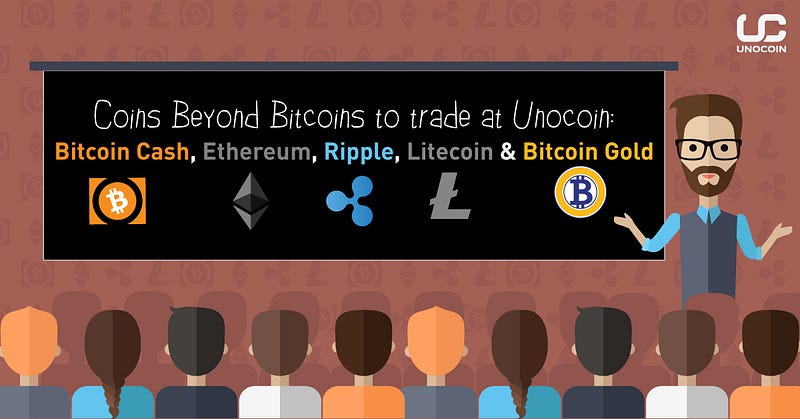
Ever since it was introduced to the world in 2008 by Satoshi Nakamoto, Bitcoin popularity has been on a one-way trajectory. Following it, many more cryptoassets naturally emerged, serving different needs. Dogecoin was introduced in 2013 for the sole purpose of mocking bitcoin, but to everyone’s surprise, even its prices soared — giving it some serious market capitalisation value.
After Bitcoin’s price skyrocketed, people naturally started looking for the ‘next bitcoin’ in other cryptoassets. Let’s have a look at these ‘next bitcoins’ which you could buy directly with the help of Unocoin.
Bitcoin Cash (BCH)
When SegWit (Bitcoin Improvement Proposal 91) was activated in July 2017, many people were not supportive. This faction felt that its adoption without an increase in Bitcoin’s block size would negatively impact bitcoin’s worldwide adoption of daily transactions. A lack of agreement led to this faction launching Bitcoin Cash with an increased block size of 8 MB instead of Bitcoin’s 1 MB.
- Bitcoin Cash’s objective was to facilitate an increasing number of transactions — something the original Bitcoin had been struggling with.
- Bitcoin Cash was a hard fork from the original Bitcoin blockchain — which means transactions of the original ledger were copied (until block 478558) before branching off into a separate blockchain.
- Since Bitcoin Cash is a hard fork, it works on the same peer-to-peer electronic network, without SegWit. Of course, there are some modifications as well.
Bitcoin Cash opened with a value of $250 per coin in August 2017. The very next day, it had reached a value of $661. After SegWit 2X was introduced, the price shot to $2500 in November. Currently, it is priced at $1300 per coin.
Ethereum (ETH)
People often mistakenly associate blockchain tech with only Bitcoin. The truth is that Bitcoin is one of the thousands of applications of the blockchain.
- Ethereum which was created by Russian computer scientist Vitalik Buterin, and was launched in 2014. It’s token (the currency required to conduct transactions on its blockchain) is called Ether.
- Ethereum is seen as a solid competitor to Bitcoin and as the next big cryptoasset by many. Its smart contracts feature gives it an edge over Bitcoin, allowing people to build self-executing applications on the blockchain. Currently, there is no hard cap on total number of Ether that can be mined.
- Bitcoin and Ethereum differ in their functioning and capability. While Bitcoin makes use of blockchain by running a peer-to-peer cashless electronic transaction system, Ethereum is capable of running smart contracts (decentralized applications).
Ether entered the market with a price of around $0.3–0.4 during its pre-sale in 2014. In 2017, Ether witnessed a huge rise of 10,000%! Its highest price was seen on January 8, 2018 — $1,321. While it has seen a dip post this, Ether’s overall performance in the cryptoasset market shows that it is one of the most desirable cryptoassets.
Ripple
Ripple is a payment protocol developed by Jed McCaleb, released in 2012 by the company Ripple Labs. Ripple is a real-time gross settlement system and a currency exchange system. While it is promoted as a cryptoasset, judging it by the way it works and was developed, it does have some differences with other cryptoassets. It has the characteristics of a centralized system working in a decentralized environment.
- When it was launched, all of its 100 billion XRP tokens were launched at once, which is its maximum limit. This leaves no scope for mining like with other coins such as Bitcoins and Ethereum.
- Another feature of Ripple that makes it different is that it is backed by many major banking institutions like American Express, Westpac etc.
- Around 60 billion tokens of the cryptoasset are owned by Ripple Labs itself. The transaction capacity of Ripple is much higher, supporting 1500 transactions per second which are far higher than Bitcoin and Ethereum.
Ripple had seen a surge in January 2018, reaching its record high level of $3 per token. It remains on the list of top 5 cryptoassets of the world because of its high market capitalisation.
Litecoin
Yet another decentralized cryptoasset inspired by Bitcoin, Litecoin too works on the principle of a peer-to-peer electronic transaction network. Charlie Lee, a former Google employee is the inventor. Lee released the Litecoin code on GitHub in 2011. Just like Bitcoin, Litecoin is not managed by any central authority and is an open source cryptoasset.
Litecoin differs from Bitcoin in the following aspects:
- Bitcoin adds a new block to its blockchain every 10 minutes, whereas Litecoin does the same task in just 2.5 minutes. Transaction time is, therefore, faster than that of Bitcoin.
- Litecoin uses scrypt as its hashing algorithm, which is easier to execute for miners. Bitcoin uses SHA-256, which is more energy intensive.
Litecoin saw huge growth in 2017. It began with a price of $4.40 per token at the beginning of 2017 and reached a record high $360.93 per token on 18 December 2017.
Bitcoin Gold
Bitcoin Gold was another hard fork from Bitcoin, after its community decided to act on making Bitcoin ‘truly decentralised’ again — by implemented a new algorithm that would allow people to mine the coins using GPUs, instead of the expensive ASIC (Application Specific Integrated Circuit) machines that are now required to feasibly mine Bitcoin.
- It was launched on 24 October 2017 and is now traded on nearly all major exchanges of the world.
- Launched at a price of $524, it now trades within a range of $120–150.
Which one will you pick?
Bitcoin is clearly responsible for helping the cryptoasset market go mainstream. Now as the market matures, the masses are keeping an eye on the next coin that will show Bitcoin-like returns. If you’re in that camp, these 5 coins may be ones you want to look at!
Also Read:
https://blog.unocoin.com/nearly-4-million-bitcoins-lost-forever-aa016341105



